Hi, fellow marketing manager.
We see you there, feverishly analyzing your meticulous campaign calendar.
You might be juggling far too many B2B SaaS marketing strategies, and need to refine your goals to make better use of your precious spend (and your time!).
Or, you might be slumped at your desk, struggling to think of a new angle or the best method to measure whether anything is actually working.
Marketing is a serious business. Especially B2B SaaS marketing, where there’s no room for error, fluff, or even a meme.
We’ve put together a six-step guide to greatness, designed to energize B2B SaaS marketing professionals and educate SaaS business owners who need to brush up on their marketing knowledge.
It’s straightforward, it’s clever, and it’s got some funny pictures.
1. Understanding B2B SaaS Marketing
Before I delve into the magical mysteries of B2B SaaS marketing, I’ve got to make sure we’re all on the same page. That means blowing the dust off the textbook and spelling everything out. Destination: Marketing 101.
Everyone and their mom know that there are crucial differences between marketing to businesses and marketing to consumers. This table breaks it down pretty simply:
|
B2B |
B2C |
|
|
Purchases are driven by... |
Results |
Emotions |
|
Content needs to... |
Educate |
Entertain |
|
Customer relationships are... |
Long-term |
Short-term |
|
Marketers must avoid... |
Fluff |
Jargon |
Without choking on a vanilla-flavoured HubSpot article about it, the crucial difference between B2B and B2C marketing is… fluff. When you’re selling something to another company, you can’t just woo them with pretty colours, a catchy slogan, and an approval sticker from PETA.
Even if you do manage to persuade the newly-veganized marketing intern, as soon as she asks the Big Boss, he’ll demand a detailed ROI analysis. You’ll never hear from them again, and she’ll probably lose her job. Woohoo.
What I’m trying to say is that to effectively market to businesses, you’ve got to cut through the crap and tell people exactly what it is you can do for them. You’ve also got to back it up, using evidence-based content, case studies, whitepapers, how-to videos, and a brand voice that emanates a sense of ‘we know what the f… we’re doing’.
That’s B2B marketing. Now throw some SaaS in the mix. Or rather, take B2B marketing principles and pump them up with steroids, because that’s essentially what’s required for SaaS companies to succeed. Not PEDs, per se, but an emphasized version of these four B2B marketing concepts:
- Results drive purchases
- Content must educate
- Customer relationships are long-term
- Marketers must avoid fluff
Purchases are Driven by Results
People will only buy your software if it’s proven to work - and work better than whatever else is on the market. B2B SaaS companies are selling to customers who are representing a business. Your customer’s decision will need to have a positive impact on their business’s ROI. So, they’ll go with the SaaS company with marketing that irrefutably proves that their service is going to help customers to ultimately be more profitable.
Content Should Educate, Not Sell
SaaS products are difficult to understand, especially if your product is different or developed with novel technology. Effective B2B SaaS marketing needs to show potential customers exactly how the product can be used by their organization and how that makes their lives easier, improves their service, strengthens their team, etc. Customers need to learn (quickly) exactly how your product works so that they can sell it to their boss and prepare to implement it into their workflow.
Customer Relationships are Long-Term
The vast majority of SaaS sales are long-term, relying on monthly or annual subscriptions from customers. This requires marketing campaigns that nurture long-term relationships with current customers, and personalized messaging to tackle specific pain points. Software develops quickly, so top SaaS companies must also demonstrate that their service is evolving and improving all the time - otherwise a competitor will take their customers.
Avoid Marketing Fluff In Content and Copy
B2B SaaS customers are representing an organization. They’ve got a busy schedule and a list of your competitors, so the pressure’s on to make a kickass first impression. There’s just no room for crappy taglines or fluffy blog posts in B2B SaaS marketing - if a sentence doesn’t offer value or demonstrate your expertise, scrap it.
But there’s one thing that separates B2B SaaS marketing from other types of other corporate marketing cliches.
As a SaaS company, the backbone of your marketing is the knowledge that your product delivers results. It doesn’t just work, it’s proven to help businesses do better, and you’ve got stacks of evidence and testimonials to prove it.
This is why one of the most successful B2B SaaS strategies is… giving the thing away for free.
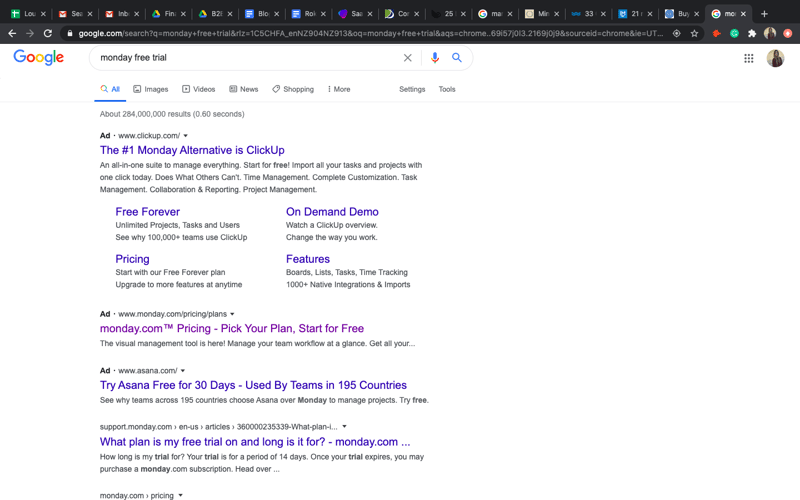
Free trials are one of the most popular forms of SaaS marketing - you give customers a taste of what your product can do, allow them to start seeing the benefits, then they’re practically throwing their money at you.
That was B2B SaaS Marketing 101. Wasn’t too bad, was it?
2. How to Manage Your SaaS Marketing Budget
We all want the very best for our company. We dream about investing in massive ad campaigns, with cinematic videos advertising your product from exotic locations, with beautiful people telling the world how amazing you are... I mean, how amazing your software is.

Marketing can be both cheap and expensive - and I’m not just talking above the above GIF. On one end, you’ve got a business owner publishing their own article on their business’s blog, and on the other end, you’ve got Kylie Jenner getting paid $1.2m per sponsored Instagram post.
Before you set forth on your campaign to start marketing campaigns, you’ve got to work out how much you can afford to spend, and what kinds of B2B SaaS marketing will be the best value for money.
There are two kinds of B2B SaaS Marketing: Inbound and Outbound. Inbound marketing is a long-term investment in content marketing strategies such as blogging, videos, case studies, whitepapers, and emails. They’re fairly low-cost, using educational and valuable content to direct organic traffic to your website.
Where inbound marketing asks for permission, before quietly offering golden nuggets of information, outbound marketing is a home invasion of abrasive messaging. Don’t get me wrong, it works, but it gives off a completely different vibe and a lot of people are losing trust in paid ads on Instagram, Facebook, and LinkedIn.
Inbound marketing costs 61% less than outbound per lead and generates 10x more leads than outbound. With that powerful statistic, it might seem like a no-brainer to throw your whole marketing spend into blogs and moonlight as your own content writer. But, it could take months before you saw any return on your investment, and B2B SaaS marketing needs the best of both strategies to generate leads now and into the future.
Here are a few tips to sort out your B2B SaaS marketing budget:
- Understand your short and long-term goals
When it comes to budgeting for marketing, you’ve got to know your priorities and stick to them. If your B2B SaaS company is new to the game, it would be wise to invest in a long-term inbound marketing strategy - with a snappy outbound campaign a couple of times per month. If you’ve slowly built up a goldmine of content on your website and have the money to spare, a few well-planned paid ad campaigns might boost your lead generation quickly.
- Develop your marketing campaigns across a calendar
To accurately calculate your annual, monthly, and weekly marketing budget, you’ve got to plot your future marketing campaigns on a calendar. This allows you to visualize the cost for each campaign during the year and estimate the total spend that’s required.
- Test thoroughly after each campaign
This part is crucial. There’s no point in throwing money into B2B SaaS marketing if you’re not going to look at the results and improve your campaigns accordingly. By reporting on the success of each B2B SaaS marketing campaign, you can make adjustments to your strategies to better allocate your budget.
- Hire an expert B2B SaaS marketing agency
Additionally, integrating enterprise SMS into your marketing strategy can enhance communication efforts, ensuring timely and direct engagement with your target audience, which can lead to higher conversion rates and improved customer retention. You don’t want to waste your budget on poorly-executed marketing efforts, right? Estimating marketing costs, planning your marketing budget, and measuring your success is most effective when you have a team of experts to help you.
3. B2B SaaS Lead Generation Tips
Ah, lead generation. The buzziest of B2B SaaS marketing buzzwords.
Essentially, you know your B2B SaaS marketing campaigns are successful when they generate leads. Depending on which campaigns you’re using at which specific part of the customer journey, you’ll get three different types of leads:
- Cold
- Warm
- Hot
Cold Leads
Cold leads are visitors who’ve only just found your company. Perhaps they’ve read a blog and they’re interested to hear more - so they provide their email address. In terms of strength, these leads are at the weaker end, so nurturing them with personalized and valuable content is essential.
Warm Leads
Warm leads have absorbed a lot of your content, even watching a few webinars and indulging in a whitepaper for some late-night reading. They’re considering a purchase, but they’re still weighing up their options and comparing you to competitors.
Hot Leads
Hot leads are about to whip out their credit card details and sign-up, so a salesperson steps in to seal the deal and establish a personal relationship.
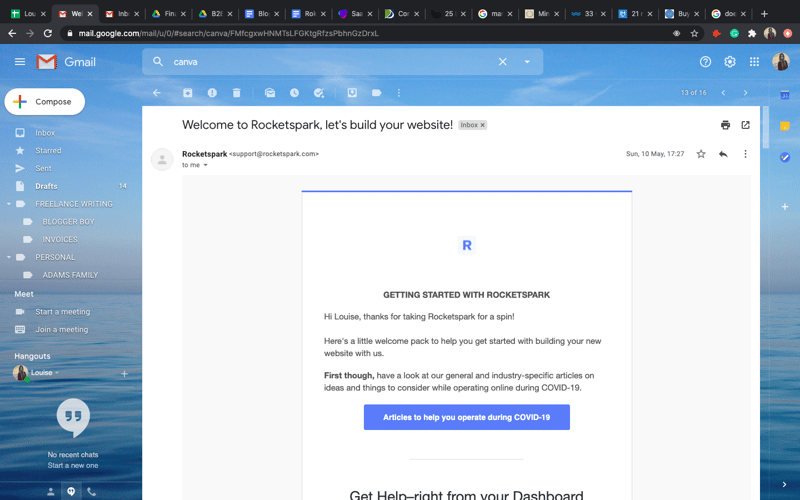
That’s a very basic breakdown of the three kinds of leads, but it shows how different marketing strategies align with each phase of the customer journey - resulting in levels of interest that need to be nurtured in different ways.
We’ve covered B2B SaaS lead generation tactics before, but I’ll run you through some of my favourite methods that you can start implementing in your content marketing, your website, your social media, and your emails.
|
Tactic |
How? |
Stat |
|
|
Website Content |
Landing pages |
Creating specific SaaS landing pages for each customer persona immediately points visitors to relevant content, then tells them exactly how and why your product is useful to them. This is a great way to heat up your leads because it communicates value and demonstrates your understanding of customers’ needs. |
Websites that are built with the knowledge of customer persona are up to 5x more effective. |
|
Content Marketing |
How-to videos |
How-to videos connect with your audience and offer a supportive walk-through of how your product works and why it’s so beneficial. |
Most marketers say video has the best ROI. |
|
Social Media |
LinkedIn Mail |
Under the guise of a personal message, marketers connect with their audience quickly. You can deliver a fairly automated message but come across as a more trustworthy, human source than a paid ad. |
LinkedIn Mail sees double the average open rate of other email marketing campaigns. |
|
Email Marketing |
Drip campaigns |
Leads that never became customers can be fed into a drip-email campaign, where they’re sent small tidbits of valuable content regularly. This method can bring leads back from the dead! |
On average, email marketing returns $42 for every $1 spent. |
3. Use Content to Attract Leads
Creating compelling content in B2B SaaS marketing is like sprinkling magic dust that captivates your target audience. With the right content strategy, you can attract leads and position your brand as an industry authority. Here are three content formats that can work wonders for your B2B SaaS marketing efforts:
Blogs
Blogs are the superheroes of the content marketing world. They allow you to showcase your expertise, educate your audience, and establish your brand's credibility. Craft engaging and informative blog posts that address pain points, provide solutions, and offer insights that resonate with your target audience.
Whitepapers
Whitepapers are the wise old sages of B2B SaaS marketing. They delve deep into industry trends, present in-depth research, and offer valuable insights to your target audience. Consider creating well-researched whitepapers that address complex challenges and provide actionable strategies. The more value you offer, the more likely you'll attract leads who see your brand as a trusted resource.
eBooks
eBooks are the charismatic storytellers of B2B SaaS marketing. They allow you to weave narratives, share success stories, and provide comprehensive guides. Craft visually appealing eBooks that blend valuable information and engaging storytelling. Your witty writing can inject personality into your content and make it an enjoyable read for your audience.
4. Use Social Media and Email Marketing to Promote Content
Creating outstanding content is just the first step. You must leverage social media and email marketing to amplify your reach and attract leads. Here are two strategies to help you promote your B2B SaaS content effectively:
Offer a Free Trial
A free trial is an irresistible bait that lures potential customers into the web of your B2B SaaS solution. Use social media platforms like LinkedIn, Twitter, and Facebook to highlight the key features and benefits of your product and emphasize that prospects can experience it firsthand through a free trial.
Encourage your audience to engage with your content, ask questions, and sign up for the trial. Make sure your copy and captivating visuals leave a lasting impression.
Use Referral Marketing
Referral marketing is the art of turning your satisfied customers into brand advocates. Encourage your existing customers to spread the word about your B2B SaaS solution by offering incentives, such as discounts or exclusive access to new features. Craft engaging and persuasive email campaigns that not only highlight the benefits of your product but also emphasize the value of sharing it with others.
Leverage social media platforms to amplify the reach of your referral program, and watch as the power of word-of-mouth helps attract a steady stream of qualified leads.
Remember, B2B SaaS marketing combines engaging content with clever promotion strategies. With the right mix of creativity and targeted messaging, you can attract leads, convert them into loyal customers, and watch your brand soar to new heights in the competitive landscape of B2B SaaS.
5. B2B SaaS Marketing Strategies
So you’ve sorted out your marketing budget and mapped out the lead generation tactics that are best suited to your target audience. Now, it’s time to walk the talk and put your planning into action. Yes, that means pushing ‘send’ and seeing what happens.
Cringe. We’ve all been there. Well, hopefully, you have more success with your marketing campaigns than your risky, heartfelt messages. And when 70% of B2B marketers are investing in more content than they did a year ago, chances are content marketing has a more positive ROI than your messaging efforts.
To energize your B2B SaaS marketing, I’ve put together some inspo from the best in the biz.
Content Marketing - Categorize Your Blogs
Blogging is perhaps the most powerful and cost-effective way to increase organic traffic to your site, assert your dominance as an industry leader, and demonstrate the intrinsic value that your business has to offer.
The value of in-depth, educational content such as blogs is increasing every year, with the ideal blog length now pitched at 2,500 words.
With increasing efforts to create a goldmine of blog content for buyer personas and SEO efforts, B2B SaaS companies need to optimize how visitors navigate their blogs to find the information that they’re looking for.
Organizing your blogs by theme, buyer persona, or service, rather than lumping everything together, provides customers with a satisfying user experience and likely encourage them to explore your content further.
For example, Monday’s blog has been split into different sections, including buyer personas, software updates, WFH tips (highly relevant), and productivity (the whole point of their service).
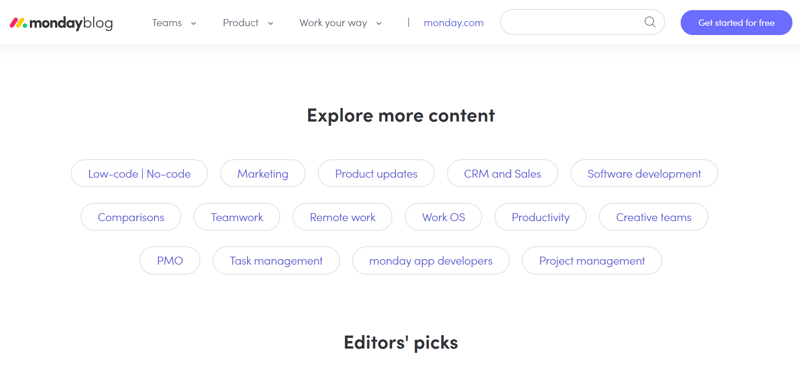
SEO Marketing - Aim For Featured Snippets
We’ve all used a featured snippet. They’re very useful if you need embarrassingly simple information quickly - such as how to scramble an egg. But they’re also a highly competitive method for B2B SaaS marketing because they take the top spot on SERPs to attract immediate attention. Nabbing a featured snippet from your competitors drops their click-through rate from 26% to 19%.
There are three main types of featured snippets up for grabs: definition, list, and table. By making a few adjustments to your content marketing strategy, you can grab the top spot at ‘position #0’ on the SERPs. Just make sure your content contains the following:
- A short definition of the topic you’re covering in the introduction
- A table showing comparisons between concepts you’re talking about
- A list summarising a step-by-step process mentioned in your blog
For example, Zapier nabbed the featured snippet for the popular comparison between Asana and Monday.
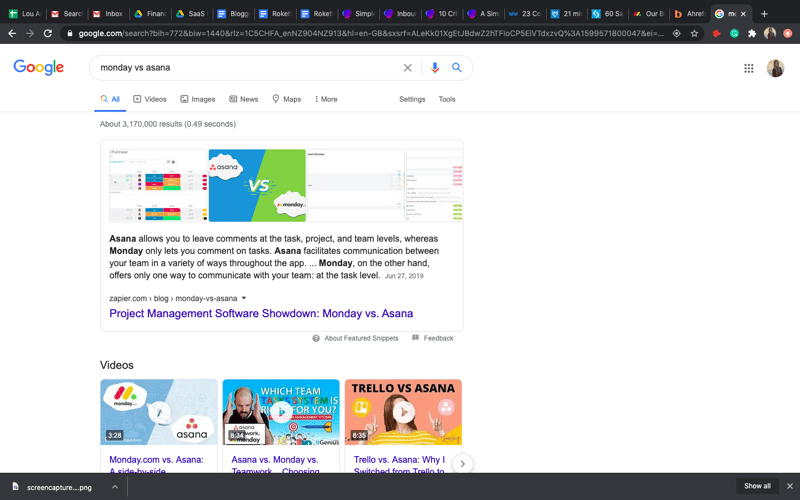
Video marketing - Sell Your Success With Case Studies
You know you’re dominating B2B SaaS marketing when your customers start selling your products for you.
That’s what case studies are all about. When 60% of people would rather watch a video than read something, and customers trust online reviews just as much as a personal recommendation from a friend, B2B SaaS companies must invest in this form of marketing. Case study videos bring together the power of video marketing with the trustworthiness of testimonials to create an unstoppable marketing force.
Case study videos tell the personal story of a customer who found success with your product. It shows potential customers the following things:
- How your product solves a real-life problem that they might be experiencing
- The positive impact your company has had on another business
- A feel-good success story to build trust and empathy
- Truly authentic marketing from a genuine customer
Videos cost a lot more than blogs, but case study videos don’t have to be flashy. As long as you have permission to interview a happy customer (and share their authentic story online) you can save the fancy animations.
For example, Salesforce has a ton of cinematic case studies where customers share their success with the CRM.
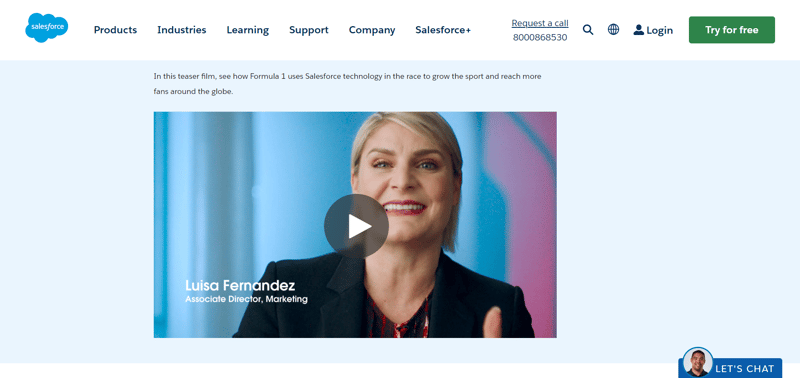
5. Measure the Success of Your B2B SaaS Marketing with Metrics
Ever heard of a B2B SaaS marketing manager who didn’t track the metrics on their campaigns? No one wants to be that guy.
Basically, without metrics analysis, you’re running your campaigns blind. You’re also probably wasting a ton of money on ineffective strategies if you’re not running the numbers and tracking long-term progress.
B2B SaaS marketing metrics involve some fairly typical stats that every other business uses, such as unique visitors, click-through rates, and customer engagement.
However, SaaS isn’t like other girls. SaaS doesn’t care about brief interactions and transactional connections, she cares about the long haul. SaaS metrics take into account the long-term potential of every customer relationship and keep track of how each one is nurtured, how many have been lost, and how many are staying strong.
We’ve dedicated a whole blog to the 10 critical B2B SaaS marketing metrics that must be tracked, but I’ll give you a sneak peek of a couple here:
- Monthly Recurring Revenue
- Churn Rate
- Unique Website Visitors
Monthly Recurring Revenue
You’re walking into Dragons Den with your B2B SaaS company. You frantically glance at your notes. What statistic will instantly demonstrate your company’s success?
Monthly recurring revenue is an easy metric to track (and remember in high-pressure meetings), but it’s critical for SaaS marketers to know what they’re working with in terms of current revenue.
This is calculated by multiplying the number of paying customers by the average amount paid per account.
It’s a quick way to the track surface-level growth of a B2B SaaS company, and it's one of the first things investors will look at to decide whether they’re impressed or not.
Churn Rate
How many times has someone left you?
No, but seriously, how many times?
The number of customers who have cancelled their subscriptions and jumped ship is called the churn rate. It might be painful to look at sometimes, but this metric is a much-needed reality check for B2B SaaS marketing managers who need to address decreasing customer satisfaction.
Calculating customer churn is very easy, it’s simply taking the number of lost customers in one month and calculating the percentage decrease.
But that wouldn’t be realistic, because most B2B SaaS companies operate with different subscription plans, so different customers pay different amounts. So, losing one big long-term spender is a much greater loss than if three cheapskates cancelled their minimum-cost subscription.
To calculate the more accurate figure of revenue churn, take the net revenue that has been lost during that month and divide it by the original total revenue that was expected at the start of the month.
Unique visitors
Quantifying the number of unique visitors to your website is a simple yet powerful way for B2B SaaS marketing managers to test whether their ToFu content marketing and website content are working with their target audience.
You just add up the total number of individual visitors to your site - so that doesn’t include you revisiting the blog post you wrote to remember how clever you are.
An essential part of calculating unique visitors is also finding out where they came from - Google, LinkedIn, Facebook, or Email Marketing. When you start to see a trend, that means your B2B SaaS marketing strategies are working - keep going!
6. Why You Should Hire a B2B SaaS Marketing Agency
Ultimately, if you’re looking to succeed with B2B SaaS marketing strategies, there’s only so much you can do from inside your business.
If you’re a marketing manager thinking ‘I’m not getting replaced by an agency!’ - don’t worry, that’s not what I’m scheming. What I’m saying is that for B2B SaaS companies to get their marketing campaigns right and kickstart their growth journey, they need expert support from a team of experts who’ve been there, done that, and got the orange HubSpot t-shirt.
And let’s face it, a lot of the background work required to create B2B SaaS marketing strategies is nit-picky, time-consuming, and straight-up boring. For one marketing manager, it’s impossible to juggle so many tasks and not have a breakdown.
Fortunately, you can find the right SaaS digital marketing agency that follows a well-established and proven process to get the hard tasks done and deliver the intel you need to drive successful marketing campaigns.
Here are just a few ways a specialized B2B SaaS digital marketing agency can help you out:
Marketing Persona Assistance
The success of B2B SaaS marketing depends on how deeply the company understands its customers. Who they are, what challenges they face, and whether they like pineapple on pizza.
Basically, the most detailed and realistic customer personas fuel the most powerful marketing campaigns, but creating them takes a great deal of research - and sometimes an unbiased outside eye from a digital marketing agency gets a more balanced view of how your company is received by customers.
Balance Between Inbound and Outbound Marketing
Making big decisions around how to allocate your marketing spend between inbound and outbound strategies is a lot of pressure for a marketing manager, especially if you’re new to some concepts.
A specialized B2B SaaS digital marketing agency comes with proven experience in your industry and can offer valuable advice from success with similar clients.
Implement a Content Marketing Strategy
Every marketing manager and their dog knows that content marketing is the king of all strategies, but that doesn’t mean they can snap their fingers and whip up an entire pillar page in one night.
With access to expert content writers and the ability to plan your content marketing strategy down to the finest details, a B2B SaaS digital marketing agency can get your company’s content marketing off the ground.
Conclusion: Smart B2B SaaS Marketing Is The Key To Growth
It’s that simple. Organized, results-driven and straight-up ballsy marketing is essential for a B2B SaaS company to be taken seriously.
If you’re a B2B SaaS marketing manager, you’ve got your work cut out for you. Big time.
We’ve covered the basics of B2B SaaS marketing, from the definition to helpful strategies, to real-world examples from companies with superhuman marketing teams.
This article might have highlighted some opportunities that you can explore at your next marketing meeting - if so, awesome!
It also might have dawned on you that your marketing campaigns need work, or you’d like to speak to a team of dedicated B2B SaaS marketing guys who can give you some informed advice.
We’re here if you need us.

Chris Onyett
Chris is one of the managing partners at Roketto. His area of expertise is digital marketing and loves sharing and educating on topics like Google Ads, CPC bidding tactics, Google Analytics, and marketing automation. When Chris isn't in the office, he enjoys playing volleyball, mountain biking, and hiking with his American Eskimo.












2.png)
2.png)


